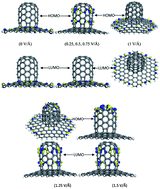Investigation on field emission properties of graphene–carbon nanotube composites
Abstract
The aim of this article is to provide a systematic evaluation to investigate the characteristics of the field emission properties of graphene–carbon nanotube composites. A model of graphene–carbon nanotube composites is established, and the C–C bond length, binding energy, energy level, ionization potential and work function are calculated by a first principles method. The results show that the composite structure formed by a combination of graphene and carbon nanotubes has higher stability and better semiconductor properties. When an electric field is applied, the orbital energy of the composite material increases and the band gap reveals a downward trend, which has a positive effect on the improvement of the field emission properties. With an increase in the electric field, the work functions and ionization potentials descend and the Mulliken charge moves effectively, which further shows that graphene–carbon nanotube composites have excellent characteristics and potential in field emission. The local electron density distribution also shows some changes. Our study is helpful to expand the application of graphene and carbon nanotubes, as well as provide a theoretical reference for the design of new field emission devices.


 Please wait while we load your content...
Please wait while we load your content...